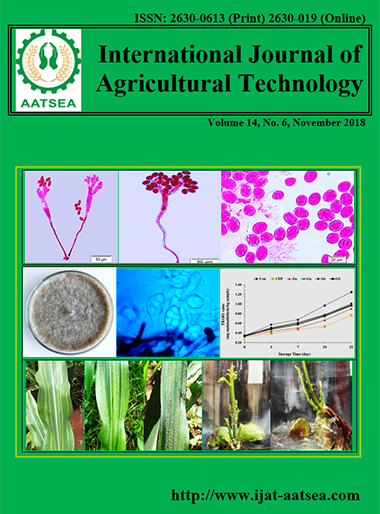Soil Genesis as Influenced by Topography of Pinkyo Area, Western Ethiopia
Main Article Content
Abstract
The influence of topography on soil genesis was investigated. Initially five slope categories (flat, level to nearly level, very gently sloping, gently sloping and sloping) were created using digital elevation model (DEM). Representative pits were opened in the five adjacent slope categories and the soils were described in situ following FAO soil description guideline. Pedon1 was deeped with weak horizon differentiation due to weak pedogenesis and classified as Eutric Fluvisols (Loamic) in WRB system of classification. Pedon 2 and 3 were deeped and classified as Haplic Vertisols (Hypereutric). Pedon 4 and 5 had shallow depth with thin (8-10 cm) surface horizons and coarse fragments in C horizon and classified as Eutric Cambisols. The soil genesis and soil type of the study area was greatly influenced by the topography of the area. This information would help for an appropriate land use planning, especially for land suitability for irrigation, since the study area is situated adjacent to Baro River, which supposed to have high potential for irrigation.
Article Details

This work is licensed under a Creative Commons Attribution-NonCommercial-NoDerivatives 4.0 International License.
References
Ahmad, N. (1983). Vertisols. In: L. P. Wilding, N. E. Smock, G. F. Hall (eds.). Pedogenesis and soil taxonomy II. The soil orders. Elsevier science publishers.
Bohn, H. L., McNeal, B. L. and O’connor G. A. (2001). Soil Chemistry. JohnWiley & Sons, 3rd edition.
Bouyoucos, G. J. (1962). Hydrometer method improvement for making particle size analysis of soils. Agronomy Journal. 54:179-186.
Bremner, J. M. and Mulvaney, C. S. (1982). Nitrogen-total. In: A.L. Page (ed.). Methods of Soil Analysis. Part 2. Chemical and microbiological properties, SSSA, Madison, Wisconsin.
Dengiz, O. (2010). Morphology, physico-chemical properties and classification of soils on Terraces of the Tigris River in the South-east Anatolia Region of Turkey. Journal of Agricultural Sciences. 16:205-212.
FAO (Food and Agriculture Organization of the United Nations). (1985). Guidelines: Land evaluation for irrigated agriculture. Soil bulletin 55.
FAO (Food and Agriculture Organization of the United Nations). (2006a). Guidelines for soil description.
FAO (Food and Agriculture Organization). (2006b). Plant nutrition for food security: A guide for integrated nutrient management. Fertilizer and Plant Nutrition Bulletin 16.
Graham, R. C. (2006). Factors of soil formation: topography. In: G. Certini and R. Scalenghe (eds.). Soil: Basic concepts and future challenges. Cambridge University Press.
Grossman, R. B. (1983). Entisols. In: L. P. Wilding, N. E. Smock and G. F. Hall (eds.). Pedogenesis and soil taxonomy II. The soil orders. Elsevier science publishers.
Hazelton, P. and Murphy, B. (2007). Interpreting Soil Test Results: What do all the numbers mean? Second edition. CSIRO Publishing.
IUSS (International Union of Soil Science) Working Group. (2014). World Reference Base for Soil Resources: A framework for international classification, correlation and communication. World Soil Resources Reports No. 106. FAO, Rome.
Jackson, M. L. (1970). Soil chemical analysis. Prentice-Hall Inc.
Jones, J. B. (2003). Agronomic Handbook: management of crops, soils, and their fertility. CRC Press, Boca Raton, Florida, USA.
Kumhalova, J., Matejkova, S., Fifernova, M., Lipavsky, J. and Kumhala, F. (2008). Topography impact on nutrition content in soil and yield. Plant soil environment.
Mulugeta Demiss and Sheleme Beyene. (2010). Characterization and classification of soils along the toposequence of KindoKoye Watershed in Southern Ethiopia. East African Journal of Sciences. 4:65-77.
Nelson, R. E. (1982). Carbonate and gypsum. In: A.L. Page, R.H. Miller and D.R. Keeney (eds.) Methods of soil analysis. Part 2. Chemical and microbiological properties. 2nd ed. Agronomy 9.
Ogbu, O. J., Usman, J., Iji, E. S. and Oyetola, S. O. (2017). Variations in morphological and physico-chemical properties as influenced by topography in southern guinea savannah zone of Nigeria. 2:116-125.
Olsen, S. R. and Somers, L. E. (1982). Phosphorus. In: A. L. Page, R. H. Miller and D. R. Keeney (eds.) Methods of soil analysis. Part 2, SSSA. Madison Wiscosin, USA.
Sahlemedhin Sertsu and Taye Bekele (eds.). (2000). Procedure for Soil and Plant Analysis. National Soil Research Centre, Ethiopian Agricultural Research Organization, Addis Ababa, Ethiopia.
Schaetzl, R. and Anderson, S. (2005). Soils Genesis and Geomorphology. Cambridge University Press.
Seibert, J., Stendah, J. and Sorensen, R. (2007). Topographical influences on soil properties in boreal forests. Geoderma. 141:139-148.
Senol, H., Tuncay, T. and Dengiz, O. (2016). Geochemical mass-balance, weathering and evolution of soils formed on a Quaternaryage basaltic toposequences. doi:10.5194/se-2016-105.
Scianna, J., Logar, R. and Pick, T. (2007). Testing and Interpreting Salt affected Soil for Tree and Shrub Plantings. Natural Resources Conservation Service, Plant Materials Technical Note No. MT- 60.
Soil Survey Staff. (2014). Keys to Soil Taxonomy. Tenth edition. United States Department of Agriculture, Natural Resources Conservation Service, Washington DC.
Sys, Ir. Van Ransi, C., E. Debaveye, Ir. J. and Beernaert, F. (1991). Land evaluation. Part II, principles in land evaluation and crop production calculations. Agricultural publications No. 7.
Tekalign, T. (1991). Soil, plant, water, fertilizer, animal manure and compost analysis. Working Document No. 13. International Livestock Research Center for Africa, Addis Ababa.
Teshome Y., Shelem B. and Kibebew, K. (2016). Characterization and classification of soils of Abobo Area, Western Ethiopia. Applied and Environmental Soil Science, Volume 2016.
USDA (United States Department of Agriculture). (1999). Soil Taxonomy. A Basic System of Soil Classification for Making and Interpreting Soil Surveys, Agriculture Handbook Natural Resources Conservation Service Number 436, United States Department of Agriculture, Washington, DC, USA, 2nd edition.
USDA (United States Department of Agriculture). (2008). Soil Quality Indicators, USDA Natural Resources Conservation Service, Washington, DC, USA.
Van Reeuwijk, L. P. (ed.). (2002). Procedure for soil analysis, 6th ed. Technical paper 9. International Soil Reference and Information Centre, Wageningen, the Netherlands.
Yeshiber. (2003). Gambella people’s regional state land-use/land allotment study. Section 9.


